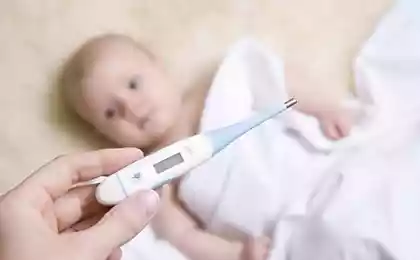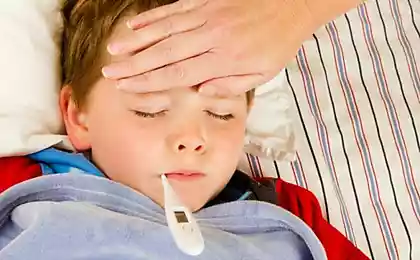673
It is necessary to know! 12 facts about high temperature
When you call the doctor to report the illness of a child, the first question he almost always asks: "is the Temperature measured?".
Further, regardless of what you communicated — 38 or 40 degrees, says to give the child an aspirin and bring it to the reception. It has become a ritual of almost all pediatricians. I suspect that many of them say memorized phrases, even if I hear about a temperature of 43 degrees.
I am concerned that pediatricians are asking the wrong questions and give wrong advice. In temperature rise, doctors see something extremely dangerous, or why she is their first concern? And advice to give baby aspirin parents inevitably conclude that the treatment should be medication to reduce temperature.

Measuring body temperature and recording its performance in the health card starts reception in most child health clinics. There is nothing wrong. Fever, indeed, is an important diagnostic symptom in the context of the follow-up survey. The problem is that she was given much more value than worth. When the doctor sees in the map entry nurses about the temperature, say, 39.5 degrees, he with a scowl, invariably says, "Wow! Need to do something!".
His concern about temperature is nonsense, and misleading nonsense. By a temperature increase to not do anything. In the absence of additional symptoms, such as unusual behavior, special weakness, shortness of breath and others, suggesting serious disease like diphtheria and meningitis, your doctor should tell parents what to worry about, and send them home with your child.
Taking into account the exaggerated attention of doctors to an elevated temperature, it is not surprising that the majority of parents, according to polls, feel the front of her huge fear. And this fear increases in proportion to the readings of the thermometer, while it is most often baseless.
Here are twelve facts relating to body temperature, the knowledge of which will help you avoid many worries, and your children to unnecessary and dangerous tests, radiology tests and medications. These facts should be taken into account by every doctor, but many pediatricians prefer to ignore them and do not consider it necessary to introduce them to parents.
Fact # 1.
Temperature of 37 degrees is not "normal" for everyone, as we are told all life. That is simply not true. Set "norm" is very conditional, because the figure is 37 degrees — the value of the average. Many people of normal temperature is higher or lower. This is especially true for children. Research revealed that body temperature of most healthy babies of 35.9-37.5 degrees, and only a few — exactly 37 degrees.
Fluctuations in body temperature of the child during the day can be significant: in the evening it is a whole degree higher than this morning. Finding the child in the afternoon, slightly increased temperature, don't worry. For this time of day is quite normal.
Fact # 2.
The temperature may rise for reasons not related to any disease: during the digestion of rich and heavy meals or at the time of ovulation among adolescent girls during their puberty. Sometimes the temperature increase is a side effect of prescription drugs — antihistamines, and others.
Fact # 3.
Temperature that is to be feared, usually has an obvious cause. In most cases, the temperature rise, which may pose a threat to health occurs either as a result of poisoning by toxic substances, or as a result of overheating (so-called heat stroke).
Classic examples of overheating soldier fainted on parade, or a marathoner coming the distance and falling from exhaustion in the sun. In such cases, the temperature may rise to 41.5 degrees or above, and risk the body harmful effects. A similar effect can be achieved overheated to excess in the bath or in the Jacuzzi.
If you suspect that child has swallowed a poisonous substance, immediately call the assistance centre in case of poisoning. When this is not possible, without waiting for trouble, immediately take the child to the hospital and, if possible, grab the package from the swallowed money — it will help to quickly find the antidote.
Usually swallowed by children chemicals are relatively harmless, but a timely appeal for help is very important.
Instant for also necessary, if the child loses consciousness, even briefly, after the outdoor games in the heat or after a bath or Jacuzzi. A call to the doctor in this situation is not enough. As soon as possible bring the child to the hospital. External influences potentially dangerous. They are able to suppress the body's defenses, which under normal conditions do not allow the temperature to rise to dangerous levels. To recognize such States help the preceding events and related symptoms. Stress: loss of consciousness means that the child is in danger.
Fact # 4.
The temperature of the body depend on the method of its measurement. Rectal (in the rectum), the temperature in children is usually one degree higher than oral (by mouth), axillary is one degree lower. However, in infants the difference between the temperature values measured by these methods, are not as large, so it is better to take temperature in the armpit.
To use a rectal thermometer, I suggest: when administered to a possible perforation of the rectum, and it's fatal in half the cases. Why risk when it is not needed? Finally, do not assume that the body temperature of a child can identify by touch, touching the forehead or the chest. It won't be possible neither the medical staff nor you.
Fact # 5.
To bring down the body temperature should not be. The only exceptions are newborn babies suffering from infections, the cause of which is often of obstetric interventions in childbirth, prenatal and hereditary disease. Acute infectious disease can be the result of some procedures. For example, an abscess under the scalp may develop from a baby from the sensors of the device for intrauterine monitoring, and aspiration pneumonia from amniotic fluid trapped in the lungs as a result of introduction of the mother during childbirth of medicines. Infection infection is possible during the excision procedure: in hospitals legions of pathogens (this is just one of the reasons why my grandchildren were born at home). If the baby in the first months of life high fever, take him to a doctor just need.
Fact # 6.
The temperature can rise from excessive wrapping. Children are very sensitive to overheating. Parents, especially first-borns, often overly concerned with not cold there for their children. They wrap kids in lots of clothes and blankets, forgetting that if he gets hot, he can't get rid of warm clothes for themselves. If baby has a fever, don't forget to check if he is too warmly dressed.
If the child with fever, especially accompanied by chills, tightly wrapped in thick blankets, this will provoke even greater growth. A simple rule that I recommend to parents of their patients: let the child be so many layers of clothing as themselves.
Fact # 7.
The majority of the cases the increase in temperature associated with viral and bacterial infections, which the body's defenses cope without any help. Colds and flu — the most common causes of temperature increase in children of any age. The temperature may rise to 40.5 degrees, but even in this case reasons for concern.
The only danger is the risk of dehydration from related processes of perspiration, a frequent pulse and respiration, coughing, vomiting, and diarrhea. You can avoid letting the child drink plenty of liquids. It would be nice if the child drink every hour a glass of water, preferably nutritious. This can be fruit juice, lemonade, tea and everything the child will not refuse. In most cases of viral and bacterial infection is easily identified by the accompanying temperature increase symptoms: slight cough, runny nose, watery eyes and so on. In these diseases need neither a doctor nor any medication. The doctor can not "prescribe" anything more effective than the body's defenses. Medications that common condition, only interfere with the action of vital forces. This is what I'll detail in a later Chapter.
Don't need antibiotics: although they can reduce the duration of bacterial infection, but the associated risk is very high.
Fact # 8.
There is no clear connection between the child's body temperature and the severity of disease. A common misconception regarding this unfounded. Moreover, consensus about what constitutes "high temperature", neither the parents, nor even among doctors. The parents of my patients, and I had a lot, had diametrically opposed views. Studies have shown that more than half of the interviewed parents consider "high" temperature of 37.7 to 38.8 degrees and almost all called the temperature of 39.5 degrees "very high". In addition, all respondents were convinced that the high temperature indicates the severity of the disease.
It is not so. Precise manner, on the clock, the measured temperature absolutely says nothing about the severity of the disease if it is caused by a viral or bacterial infection. Once you understand that the reason for the temperature — infection, stop to measure the temperature every hour. Tracking its increase in this disease will not help, moreover, it will only exacerbate your fears and will tire the child.
Some simple, harmless diseases like measles a day, sometimes causing children have a very high temperature, while other, more serious, may occur without its increase. If additional symptoms like vomiting or difficulty breathing no, keep calm. Even if the temperature rises to 40.5 degrees.
To determine easy, like the common cold, or serious, like meningitis, the disease is caused by temperature, it is important to consider the General condition of the child, his behavior and appearance. All these points you will appreciate much better than the doctor. You much better know how your child usually looks and how it behaves. If you are experiencing unusual lethargy, confusion and other disturbing symptoms that continue for a day or two, it makes sense to call the doctor. If the child is active, has not changed his behavior, no reason to fear that he is seriously ill, no.
From time to time in pediatric journals come across articles about "temperatureprobe" — about undue parental fear of increased temperature in children. The doctors coined the term — typical for people of my profession tactic of "blame the victim" doctors are never wrong, and if errors occur, all the fault of the patients. In my opinion, "temperatureprobe" — a disease of pediatricians, not parents. And it is the doctors fault that the parents become its victims.
Fact # 9.
Temperature, caused by viral or bacterial infection, if it does not knock, will not rise above 41 degrees. Pediatricians do a disservice, prescribing antipyretics. As a result of their appointments, the anxiety of the parents about what the temperature may rise to an extreme limit, if no action is taken, supported and enhanced. Doctors do not say that the churning temperature on the process of recovery is not affected, as well as the fact that the human body has a mechanism (not yet fully explained), which does not allow the temperature to overcome the barrier of 41 degrees.
Only in heat stroke, poisonings and other external influences this natural mechanism may not work. In such cases, the temperature rises above 41 degrees. Doctors know this, but most of them do not know. I believe that their behavior is motivated by a desire to demonstrate their care to the child. In addition, this is common for physicians the desire to intervene in any situation and the unwillingness to recognize that there are States that they are not able to treat effectively. In addition to the deadly, incurable disease, what the doctor decides to tell the patient: "I can't do anything"?
Fact No. 10.
Measures to reduce temperature, whether the use of antipyretics or sponging with water, is not only unnecessary, but harmful. If the child has an infection, the fever, which is accompanied by the course of the disease, parents should be seen not as a curse but as a blessing. The temperature rises as a result of spontaneous generation of pyrogens — substances that cause fever. This is a natural defense of the body against disease. The increase in temperature suggests that the healing system of the body involved and working.
The process develops as follows: an infectious disease the child's body responds by production of additional white blood cells — leukocytes. They kill bacteria and viruses and cleanse the body of damaged tissue and decomposition products. The activity of white blood cells it increases, they quickly move to the site of infection. This part of the process, the so-called leukotoxin, stimulates the production of pyrogens, raising body temperature. Increased temperature suggests that the process of healing is accelerated. This does not need to be afraid, that is something to rejoice.
But that's not all. Iron, which serves as a source of food for many bacteria leaves the blood and accumulates in the liver. This reduces the breeding rate of bacteria and increases the effectiveness of interferon produced by the body to fight disease.
This process has been demonstrated by scientists in laboratory experiments on infected animals. When the artificial increase in temperature, the mortality of experimental animals from infection decreased, and the decrease increased. An artificial increase in body temperature has long been used in cases where the patient has lost the natural ability of this diseases.
If the temperature of the child rose as a result of infection, resist the urge to throw her medicines or rubbing. Let the temperature do its thing. Well, if your compassion required to alleviate the patient's condition, give your child paracetamol dosage age-appropriate or wipe the body with warm water. This is quite enough. A doctor is needed only when the fever lasts more than three days, there were other symptoms or the child became very sick.
I emphasize: reducing the temperature to relieve the condition of the child, you are interfering in the natural process of healing. The only reason that compels me to talk about how to reduce the temperature, — the knowledge that some parents are not able to resist.
If you do not bring the temperature down you can't, wiping water is preferable taking aspirin and paracetamol, because of their danger. Despite the popularity, these funds are far from harmless. Aspirin poisoning every year, perhaps more children than any other poison. This is the same form of salicylic acid, which is used as the Foundation anticoagulant in rat poisons — rat, eating it, die from internal bleeding.
Aspirin can cause a number of side effects in children and adults. One of them is intestinal bleeding. If children receive this medication during the flu or chickenpox, they may develop Reye's syndrome — a common cause of child mortality, mainly due to the impact on the brain and liver. This is partly why many doctors switched from aspirin to paracetamol (acetaminophen, Panadol, calpol, etc.).
Reception of funds is not out of position. There is evidence that large doses of this drug toxic to the liver and kidneys. Draw your attention to the fact that children whose mothers have taken aspirin during delivery often suffer from a cephalhaematoma removed state, in which in the head appear fluid-filled bumps.
If you do decide to reduce the child's temperature by sponging, use only warm water. The decrease in body temperature is achieved by water evaporation from the skin and the temperature of the water does not. That is why too cold water has benefits. Not suitable for wiping and alcohol: vapours toxic for the baby.
Fact # 11.
High temperature caused by a viral or bacterial infection, does not lead to brain damage and does not cause other negative consequences. Fear of high temperature stems in part from the widespread view that it can lead to irreversible brain damage or other bodies. If this were so, the panic of the parents when the temperature increases would be justified. But, as I said, the assertion is false.
Those who are familiar with this fear, I advise you to forget about what it sowed, and never take for granted the words about the threat of high temperature, regardless of where they come from — from other parents, older people or friend the doctor, handing out friendly advice over a Cup of coffee. And even if such advice was given to the all-knowing grandmother. Law it is, alas, not always. Colds, flu and any other infection will not raise the child's body temperature above 41 degrees, and temperatures below this level will not cause long-term harm.
No need to expose yourself to the fear of possible brain damage in a child while raising his temperature: the body's defenses will not allow the temperature to rise above 41 degrees. I don't think even pediatricians who practiced decades have seen more than one or two cases with high temperature. Temperature rise above 41 degrees is not caused by infection, poisoning or overheating. I have treated tens of thousands of children and only once watched his patient's temperature above 41 degrees. This is not surprising. Studies have shown that in 95 percent of cases raising the temperature in children it did not rise above 40.5 degrees.
Fact # 12.
High temperature does not cause cramping. Their is a sharp rise in temperature. Many parents are afraid of high fever in their children, as he noticed that she was accompanied by convulsions. They believe that seizures cause "too high" temperature. I understand these parents: the child is in the throes of the spectacle unbearable. Those who have seen this may be hard to believe that, as a rule, this condition is not serious. In addition, it is relatively rare — only 4 percent of children with high fever convulsions are observed, and there is no evidence that they leave serious consequences.
Study 1 706 children who have experienced febrile convulsions, found no cases of violations of motility and did not record deaths. There are also convincing evidence that such seizures increase the risk of later epilepsy.
Moreover, measures for the prevention of febrile convulsions — receiving antipyretic drugs and rubbing — almost always implemented too late and hence, in vain: to the time of the discovery of the high temperature of the child, most often, the seizure threshold is already passed. As I said, the convulsions do not depend on the temperature level and the speed of its rise to a high level. If the temperature rose sharply, cramps, or already happened, or the danger had passed them, that is, to prevent them is almost impossible.
To febrile convulsions tend children up to five years. Children who experienced such seizures in this age, in the next are affected by them rarely. To prevent the recurrence of convulsions at high temperature many doctors are prescribing children long-term treatment with phenobarbital and other anticonvulsant drugs. If such funds are prescribed to your child, ask your doctor about the risks associated with them, and about what changes in the child's behavior they lead to.
In General, in terms of long-term treatment of febrile seizures unanimity among the doctors there. Medications that are commonly used in this case, cause liver damage and even, as shown by experiments on animals that negatively affect the brain. One of the authorities in this matter, once said: "Sometimes the patient is healthier to live a normal life between episodes of seizures, rather than to live on drugs without convulsions, but in a constant state of drowsiness and confusion...".
I was taught to prescribe to children with febrile seizures (to prevent their recurrence) phenobarbital, current medical students are taught the same. Doubts about the correctness of use of this drug have emerged when I noticed that the treatment of them in some patients seizures recur. This naturally made wonder whether due to the phenobarbital in the remaining patients they stopped? My suspicions intensified after complaints from some mothers that the drug perevozbuzdenie children or retards that are usually active and sociable, they suddenly turn into palusami. Because seizures are episodic and do not leave lasting effects, I stopped to prescribe this medication to their young patients.
If experiencing febrile convulsions the child will prescribe long-term treatment, parents have to decide whether to accept it or not. I understand that to openly Express doubts about the doctor's appointments difficult. Know that your doctor may shrug off questions or give intelligible answers. If that happens, it makes no sense to argue. It is necessary to take the doctor and a prescription before you buy medication, ask for advice from another doctor.
If your child has started temperature related cramps, try not to panic. Of course, the advice much easier to give than to follow them. The spectacle of a child with seizures is really scary. And I will remind myself that seizures are not life threatening to your baby and will not bring irreversible damage, and take simple steps to ensure that the child was not injured during the attack.
First, turn child to one side so he wouldn't choke on saliva. Then make sure to near its head was not solid and sharp objects that he could get hurt during the attack. Making sure that the breath of a baby prevents and place a firm, but not sharp object between his teeth — for example, clean folded leather glove or wallet (not finger!), so he accidentally bit his tongue. Then, for your own peace, you can call the doctor and tell him about what happened.
For the most part the cramps last for a few minutes. If they will be delayed, ask for the advice of a physician. If after an attack of convulsions, the child will not fall asleep, give him food and drink not in the next hour. Because of the severe drowsiness he might choke.
A quick guide to body temperature
High temperature is common in children, a symptom that is not associated with severe disease (in the absence of other worrying symptoms such as an unusual appearance and behaviour, difficulty in breathing and loss of consciousness). It is not an indicator of severity of the disease.
Temperature rising as a result of infection does not reach the values, at which possible irreversible damage of organs of the child.
Fever does not require medical intervention beyond what is recommended below. The temperature should knock. It is a natural defense of the body against infection and helps speedy healing.
1. If the body temperature of the child for up to two months rose above 37.7 degrees, contact your doctor. It can be a symptom of an infection in — utero or related intervention in the birth process. Fever in children of this age is so unusual that it would be wiser to err and more likely to calm down if the alarm is false.
2. For children older than two months the doctor when the temperature is not needed, except when the fever lasts more than three days or is accompanied by severe symptoms — vomiting, shortness of breath, severe cough for several days and others, not characteristic of a cold. Consult your doctor if the child is unusually lethargic, irritable, distracted or looks seriously ill.
3. Contact your doctor regardless of the temperature if the child has difficulty breathing, uncontrollable vomiting, if the temperature is accompanied by involuntary muscle twitching or other strange movements or are worried about something else in the behavior and appearance of the child.
4. If the temperature rise is accompanied by a fever, do not try to cope with this feeling of the child with blankets. This will lead to even more drastic increase in temperature. Fever is not dangerous — it is a normal reaction, a mechanism of adaptation to higher temperature. It does not mean that the child is cold.
5. Temperaturesare try to put the baby to bed, but don't overdo it. There is no need to chain the child to bed and keep it at home if the weather is not too bad. Fresh air and moderate activity will improve the baby's mood without worsening the condition, and make your life easier. However too intense exercise and athletic competition is not necessary to encourage.
6. If there is reason to suspect as the cause of the high temperature, not infection, and other circumstances, overheating or poisoning, bring the child to the hospital immediately. If your location has no emergency room, use any available medical help.
7. Do not try, according to popular tradition, "starve a fever". Nutrition is important for recovery from any illness. If the child has no counter, "scarletite" and colds, and fever. And they both burn the reserves of proteins, fats and carbohydrates in the body, and they need to compensate. If the child refuses to eat, give him nutritious liquids, such as fruit juice. And don't forget that chicken soup is beneficial to all.
High temperature and usually accompanying symptoms lead to significant loss of fluids and cause dehydration. It can be avoided, giving the child plenty to drink, preferably fruit juices, but if he does not want, any suitable liquid, preferably one glass every hour.published
From the book by Robert Mendelsohn, "How to raise a healthy child in spite of doctors."
P. S. And remember, only by changing their consumption — together we change the world! ©
Join us in Facebook , Vkontakte, Odnoklassniki
Source: soznatelno.ru/zdorovaya-semya/dvenadcat-faktov-o-vysokoiy-temperature.html
Further, regardless of what you communicated — 38 or 40 degrees, says to give the child an aspirin and bring it to the reception. It has become a ritual of almost all pediatricians. I suspect that many of them say memorized phrases, even if I hear about a temperature of 43 degrees.
I am concerned that pediatricians are asking the wrong questions and give wrong advice. In temperature rise, doctors see something extremely dangerous, or why she is their first concern? And advice to give baby aspirin parents inevitably conclude that the treatment should be medication to reduce temperature.

Measuring body temperature and recording its performance in the health card starts reception in most child health clinics. There is nothing wrong. Fever, indeed, is an important diagnostic symptom in the context of the follow-up survey. The problem is that she was given much more value than worth. When the doctor sees in the map entry nurses about the temperature, say, 39.5 degrees, he with a scowl, invariably says, "Wow! Need to do something!".
His concern about temperature is nonsense, and misleading nonsense. By a temperature increase to not do anything. In the absence of additional symptoms, such as unusual behavior, special weakness, shortness of breath and others, suggesting serious disease like diphtheria and meningitis, your doctor should tell parents what to worry about, and send them home with your child.
Taking into account the exaggerated attention of doctors to an elevated temperature, it is not surprising that the majority of parents, according to polls, feel the front of her huge fear. And this fear increases in proportion to the readings of the thermometer, while it is most often baseless.
Here are twelve facts relating to body temperature, the knowledge of which will help you avoid many worries, and your children to unnecessary and dangerous tests, radiology tests and medications. These facts should be taken into account by every doctor, but many pediatricians prefer to ignore them and do not consider it necessary to introduce them to parents.
Fact # 1.
Temperature of 37 degrees is not "normal" for everyone, as we are told all life. That is simply not true. Set "norm" is very conditional, because the figure is 37 degrees — the value of the average. Many people of normal temperature is higher or lower. This is especially true for children. Research revealed that body temperature of most healthy babies of 35.9-37.5 degrees, and only a few — exactly 37 degrees.
Fluctuations in body temperature of the child during the day can be significant: in the evening it is a whole degree higher than this morning. Finding the child in the afternoon, slightly increased temperature, don't worry. For this time of day is quite normal.
Fact # 2.
The temperature may rise for reasons not related to any disease: during the digestion of rich and heavy meals or at the time of ovulation among adolescent girls during their puberty. Sometimes the temperature increase is a side effect of prescription drugs — antihistamines, and others.
Fact # 3.
Temperature that is to be feared, usually has an obvious cause. In most cases, the temperature rise, which may pose a threat to health occurs either as a result of poisoning by toxic substances, or as a result of overheating (so-called heat stroke).
Classic examples of overheating soldier fainted on parade, or a marathoner coming the distance and falling from exhaustion in the sun. In such cases, the temperature may rise to 41.5 degrees or above, and risk the body harmful effects. A similar effect can be achieved overheated to excess in the bath or in the Jacuzzi.
If you suspect that child has swallowed a poisonous substance, immediately call the assistance centre in case of poisoning. When this is not possible, without waiting for trouble, immediately take the child to the hospital and, if possible, grab the package from the swallowed money — it will help to quickly find the antidote.
Usually swallowed by children chemicals are relatively harmless, but a timely appeal for help is very important.
Instant for also necessary, if the child loses consciousness, even briefly, after the outdoor games in the heat or after a bath or Jacuzzi. A call to the doctor in this situation is not enough. As soon as possible bring the child to the hospital. External influences potentially dangerous. They are able to suppress the body's defenses, which under normal conditions do not allow the temperature to rise to dangerous levels. To recognize such States help the preceding events and related symptoms. Stress: loss of consciousness means that the child is in danger.
Fact # 4.
The temperature of the body depend on the method of its measurement. Rectal (in the rectum), the temperature in children is usually one degree higher than oral (by mouth), axillary is one degree lower. However, in infants the difference between the temperature values measured by these methods, are not as large, so it is better to take temperature in the armpit.
To use a rectal thermometer, I suggest: when administered to a possible perforation of the rectum, and it's fatal in half the cases. Why risk when it is not needed? Finally, do not assume that the body temperature of a child can identify by touch, touching the forehead or the chest. It won't be possible neither the medical staff nor you.
Fact # 5.
To bring down the body temperature should not be. The only exceptions are newborn babies suffering from infections, the cause of which is often of obstetric interventions in childbirth, prenatal and hereditary disease. Acute infectious disease can be the result of some procedures. For example, an abscess under the scalp may develop from a baby from the sensors of the device for intrauterine monitoring, and aspiration pneumonia from amniotic fluid trapped in the lungs as a result of introduction of the mother during childbirth of medicines. Infection infection is possible during the excision procedure: in hospitals legions of pathogens (this is just one of the reasons why my grandchildren were born at home). If the baby in the first months of life high fever, take him to a doctor just need.
Fact # 6.
The temperature can rise from excessive wrapping. Children are very sensitive to overheating. Parents, especially first-borns, often overly concerned with not cold there for their children. They wrap kids in lots of clothes and blankets, forgetting that if he gets hot, he can't get rid of warm clothes for themselves. If baby has a fever, don't forget to check if he is too warmly dressed.
If the child with fever, especially accompanied by chills, tightly wrapped in thick blankets, this will provoke even greater growth. A simple rule that I recommend to parents of their patients: let the child be so many layers of clothing as themselves.
Fact # 7.
The majority of the cases the increase in temperature associated with viral and bacterial infections, which the body's defenses cope without any help. Colds and flu — the most common causes of temperature increase in children of any age. The temperature may rise to 40.5 degrees, but even in this case reasons for concern.
The only danger is the risk of dehydration from related processes of perspiration, a frequent pulse and respiration, coughing, vomiting, and diarrhea. You can avoid letting the child drink plenty of liquids. It would be nice if the child drink every hour a glass of water, preferably nutritious. This can be fruit juice, lemonade, tea and everything the child will not refuse. In most cases of viral and bacterial infection is easily identified by the accompanying temperature increase symptoms: slight cough, runny nose, watery eyes and so on. In these diseases need neither a doctor nor any medication. The doctor can not "prescribe" anything more effective than the body's defenses. Medications that common condition, only interfere with the action of vital forces. This is what I'll detail in a later Chapter.
Don't need antibiotics: although they can reduce the duration of bacterial infection, but the associated risk is very high.
Fact # 8.
There is no clear connection between the child's body temperature and the severity of disease. A common misconception regarding this unfounded. Moreover, consensus about what constitutes "high temperature", neither the parents, nor even among doctors. The parents of my patients, and I had a lot, had diametrically opposed views. Studies have shown that more than half of the interviewed parents consider "high" temperature of 37.7 to 38.8 degrees and almost all called the temperature of 39.5 degrees "very high". In addition, all respondents were convinced that the high temperature indicates the severity of the disease.
It is not so. Precise manner, on the clock, the measured temperature absolutely says nothing about the severity of the disease if it is caused by a viral or bacterial infection. Once you understand that the reason for the temperature — infection, stop to measure the temperature every hour. Tracking its increase in this disease will not help, moreover, it will only exacerbate your fears and will tire the child.
Some simple, harmless diseases like measles a day, sometimes causing children have a very high temperature, while other, more serious, may occur without its increase. If additional symptoms like vomiting or difficulty breathing no, keep calm. Even if the temperature rises to 40.5 degrees.
To determine easy, like the common cold, or serious, like meningitis, the disease is caused by temperature, it is important to consider the General condition of the child, his behavior and appearance. All these points you will appreciate much better than the doctor. You much better know how your child usually looks and how it behaves. If you are experiencing unusual lethargy, confusion and other disturbing symptoms that continue for a day or two, it makes sense to call the doctor. If the child is active, has not changed his behavior, no reason to fear that he is seriously ill, no.
From time to time in pediatric journals come across articles about "temperatureprobe" — about undue parental fear of increased temperature in children. The doctors coined the term — typical for people of my profession tactic of "blame the victim" doctors are never wrong, and if errors occur, all the fault of the patients. In my opinion, "temperatureprobe" — a disease of pediatricians, not parents. And it is the doctors fault that the parents become its victims.
Fact # 9.
Temperature, caused by viral or bacterial infection, if it does not knock, will not rise above 41 degrees. Pediatricians do a disservice, prescribing antipyretics. As a result of their appointments, the anxiety of the parents about what the temperature may rise to an extreme limit, if no action is taken, supported and enhanced. Doctors do not say that the churning temperature on the process of recovery is not affected, as well as the fact that the human body has a mechanism (not yet fully explained), which does not allow the temperature to overcome the barrier of 41 degrees.
Only in heat stroke, poisonings and other external influences this natural mechanism may not work. In such cases, the temperature rises above 41 degrees. Doctors know this, but most of them do not know. I believe that their behavior is motivated by a desire to demonstrate their care to the child. In addition, this is common for physicians the desire to intervene in any situation and the unwillingness to recognize that there are States that they are not able to treat effectively. In addition to the deadly, incurable disease, what the doctor decides to tell the patient: "I can't do anything"?
Fact No. 10.
Measures to reduce temperature, whether the use of antipyretics or sponging with water, is not only unnecessary, but harmful. If the child has an infection, the fever, which is accompanied by the course of the disease, parents should be seen not as a curse but as a blessing. The temperature rises as a result of spontaneous generation of pyrogens — substances that cause fever. This is a natural defense of the body against disease. The increase in temperature suggests that the healing system of the body involved and working.
The process develops as follows: an infectious disease the child's body responds by production of additional white blood cells — leukocytes. They kill bacteria and viruses and cleanse the body of damaged tissue and decomposition products. The activity of white blood cells it increases, they quickly move to the site of infection. This part of the process, the so-called leukotoxin, stimulates the production of pyrogens, raising body temperature. Increased temperature suggests that the process of healing is accelerated. This does not need to be afraid, that is something to rejoice.
But that's not all. Iron, which serves as a source of food for many bacteria leaves the blood and accumulates in the liver. This reduces the breeding rate of bacteria and increases the effectiveness of interferon produced by the body to fight disease.
This process has been demonstrated by scientists in laboratory experiments on infected animals. When the artificial increase in temperature, the mortality of experimental animals from infection decreased, and the decrease increased. An artificial increase in body temperature has long been used in cases where the patient has lost the natural ability of this diseases.
If the temperature of the child rose as a result of infection, resist the urge to throw her medicines or rubbing. Let the temperature do its thing. Well, if your compassion required to alleviate the patient's condition, give your child paracetamol dosage age-appropriate or wipe the body with warm water. This is quite enough. A doctor is needed only when the fever lasts more than three days, there were other symptoms or the child became very sick.
I emphasize: reducing the temperature to relieve the condition of the child, you are interfering in the natural process of healing. The only reason that compels me to talk about how to reduce the temperature, — the knowledge that some parents are not able to resist.
If you do not bring the temperature down you can't, wiping water is preferable taking aspirin and paracetamol, because of their danger. Despite the popularity, these funds are far from harmless. Aspirin poisoning every year, perhaps more children than any other poison. This is the same form of salicylic acid, which is used as the Foundation anticoagulant in rat poisons — rat, eating it, die from internal bleeding.
Aspirin can cause a number of side effects in children and adults. One of them is intestinal bleeding. If children receive this medication during the flu or chickenpox, they may develop Reye's syndrome — a common cause of child mortality, mainly due to the impact on the brain and liver. This is partly why many doctors switched from aspirin to paracetamol (acetaminophen, Panadol, calpol, etc.).
Reception of funds is not out of position. There is evidence that large doses of this drug toxic to the liver and kidneys. Draw your attention to the fact that children whose mothers have taken aspirin during delivery often suffer from a cephalhaematoma removed state, in which in the head appear fluid-filled bumps.
If you do decide to reduce the child's temperature by sponging, use only warm water. The decrease in body temperature is achieved by water evaporation from the skin and the temperature of the water does not. That is why too cold water has benefits. Not suitable for wiping and alcohol: vapours toxic for the baby.
Fact # 11.
High temperature caused by a viral or bacterial infection, does not lead to brain damage and does not cause other negative consequences. Fear of high temperature stems in part from the widespread view that it can lead to irreversible brain damage or other bodies. If this were so, the panic of the parents when the temperature increases would be justified. But, as I said, the assertion is false.
Those who are familiar with this fear, I advise you to forget about what it sowed, and never take for granted the words about the threat of high temperature, regardless of where they come from — from other parents, older people or friend the doctor, handing out friendly advice over a Cup of coffee. And even if such advice was given to the all-knowing grandmother. Law it is, alas, not always. Colds, flu and any other infection will not raise the child's body temperature above 41 degrees, and temperatures below this level will not cause long-term harm.
No need to expose yourself to the fear of possible brain damage in a child while raising his temperature: the body's defenses will not allow the temperature to rise above 41 degrees. I don't think even pediatricians who practiced decades have seen more than one or two cases with high temperature. Temperature rise above 41 degrees is not caused by infection, poisoning or overheating. I have treated tens of thousands of children and only once watched his patient's temperature above 41 degrees. This is not surprising. Studies have shown that in 95 percent of cases raising the temperature in children it did not rise above 40.5 degrees.
Fact # 12.
High temperature does not cause cramping. Their is a sharp rise in temperature. Many parents are afraid of high fever in their children, as he noticed that she was accompanied by convulsions. They believe that seizures cause "too high" temperature. I understand these parents: the child is in the throes of the spectacle unbearable. Those who have seen this may be hard to believe that, as a rule, this condition is not serious. In addition, it is relatively rare — only 4 percent of children with high fever convulsions are observed, and there is no evidence that they leave serious consequences.
Study 1 706 children who have experienced febrile convulsions, found no cases of violations of motility and did not record deaths. There are also convincing evidence that such seizures increase the risk of later epilepsy.
Moreover, measures for the prevention of febrile convulsions — receiving antipyretic drugs and rubbing — almost always implemented too late and hence, in vain: to the time of the discovery of the high temperature of the child, most often, the seizure threshold is already passed. As I said, the convulsions do not depend on the temperature level and the speed of its rise to a high level. If the temperature rose sharply, cramps, or already happened, or the danger had passed them, that is, to prevent them is almost impossible.
To febrile convulsions tend children up to five years. Children who experienced such seizures in this age, in the next are affected by them rarely. To prevent the recurrence of convulsions at high temperature many doctors are prescribing children long-term treatment with phenobarbital and other anticonvulsant drugs. If such funds are prescribed to your child, ask your doctor about the risks associated with them, and about what changes in the child's behavior they lead to.
In General, in terms of long-term treatment of febrile seizures unanimity among the doctors there. Medications that are commonly used in this case, cause liver damage and even, as shown by experiments on animals that negatively affect the brain. One of the authorities in this matter, once said: "Sometimes the patient is healthier to live a normal life between episodes of seizures, rather than to live on drugs without convulsions, but in a constant state of drowsiness and confusion...".
I was taught to prescribe to children with febrile seizures (to prevent their recurrence) phenobarbital, current medical students are taught the same. Doubts about the correctness of use of this drug have emerged when I noticed that the treatment of them in some patients seizures recur. This naturally made wonder whether due to the phenobarbital in the remaining patients they stopped? My suspicions intensified after complaints from some mothers that the drug perevozbuzdenie children or retards that are usually active and sociable, they suddenly turn into palusami. Because seizures are episodic and do not leave lasting effects, I stopped to prescribe this medication to their young patients.
If experiencing febrile convulsions the child will prescribe long-term treatment, parents have to decide whether to accept it or not. I understand that to openly Express doubts about the doctor's appointments difficult. Know that your doctor may shrug off questions or give intelligible answers. If that happens, it makes no sense to argue. It is necessary to take the doctor and a prescription before you buy medication, ask for advice from another doctor.
If your child has started temperature related cramps, try not to panic. Of course, the advice much easier to give than to follow them. The spectacle of a child with seizures is really scary. And I will remind myself that seizures are not life threatening to your baby and will not bring irreversible damage, and take simple steps to ensure that the child was not injured during the attack.
First, turn child to one side so he wouldn't choke on saliva. Then make sure to near its head was not solid and sharp objects that he could get hurt during the attack. Making sure that the breath of a baby prevents and place a firm, but not sharp object between his teeth — for example, clean folded leather glove or wallet (not finger!), so he accidentally bit his tongue. Then, for your own peace, you can call the doctor and tell him about what happened.
For the most part the cramps last for a few minutes. If they will be delayed, ask for the advice of a physician. If after an attack of convulsions, the child will not fall asleep, give him food and drink not in the next hour. Because of the severe drowsiness he might choke.
A quick guide to body temperature
High temperature is common in children, a symptom that is not associated with severe disease (in the absence of other worrying symptoms such as an unusual appearance and behaviour, difficulty in breathing and loss of consciousness). It is not an indicator of severity of the disease.
Temperature rising as a result of infection does not reach the values, at which possible irreversible damage of organs of the child.
Fever does not require medical intervention beyond what is recommended below. The temperature should knock. It is a natural defense of the body against infection and helps speedy healing.
1. If the body temperature of the child for up to two months rose above 37.7 degrees, contact your doctor. It can be a symptom of an infection in — utero or related intervention in the birth process. Fever in children of this age is so unusual that it would be wiser to err and more likely to calm down if the alarm is false.
2. For children older than two months the doctor when the temperature is not needed, except when the fever lasts more than three days or is accompanied by severe symptoms — vomiting, shortness of breath, severe cough for several days and others, not characteristic of a cold. Consult your doctor if the child is unusually lethargic, irritable, distracted or looks seriously ill.
3. Contact your doctor regardless of the temperature if the child has difficulty breathing, uncontrollable vomiting, if the temperature is accompanied by involuntary muscle twitching or other strange movements or are worried about something else in the behavior and appearance of the child.
4. If the temperature rise is accompanied by a fever, do not try to cope with this feeling of the child with blankets. This will lead to even more drastic increase in temperature. Fever is not dangerous — it is a normal reaction, a mechanism of adaptation to higher temperature. It does not mean that the child is cold.
5. Temperaturesare try to put the baby to bed, but don't overdo it. There is no need to chain the child to bed and keep it at home if the weather is not too bad. Fresh air and moderate activity will improve the baby's mood without worsening the condition, and make your life easier. However too intense exercise and athletic competition is not necessary to encourage.
6. If there is reason to suspect as the cause of the high temperature, not infection, and other circumstances, overheating or poisoning, bring the child to the hospital immediately. If your location has no emergency room, use any available medical help.
7. Do not try, according to popular tradition, "starve a fever". Nutrition is important for recovery from any illness. If the child has no counter, "scarletite" and colds, and fever. And they both burn the reserves of proteins, fats and carbohydrates in the body, and they need to compensate. If the child refuses to eat, give him nutritious liquids, such as fruit juice. And don't forget that chicken soup is beneficial to all.
High temperature and usually accompanying symptoms lead to significant loss of fluids and cause dehydration. It can be avoided, giving the child plenty to drink, preferably fruit juices, but if he does not want, any suitable liquid, preferably one glass every hour.published
From the book by Robert Mendelsohn, "How to raise a healthy child in spite of doctors."
P. S. And remember, only by changing their consumption — together we change the world! ©
Join us in Facebook , Vkontakte, Odnoklassniki
Source: soznatelno.ru/zdorovaya-semya/dvenadcat-faktov-o-vysokoiy-temperature.html
Naola Vinaver: the Ancient art of obstetrics in Mexico
Swimmer who saved 20 people and nearly killed himself























